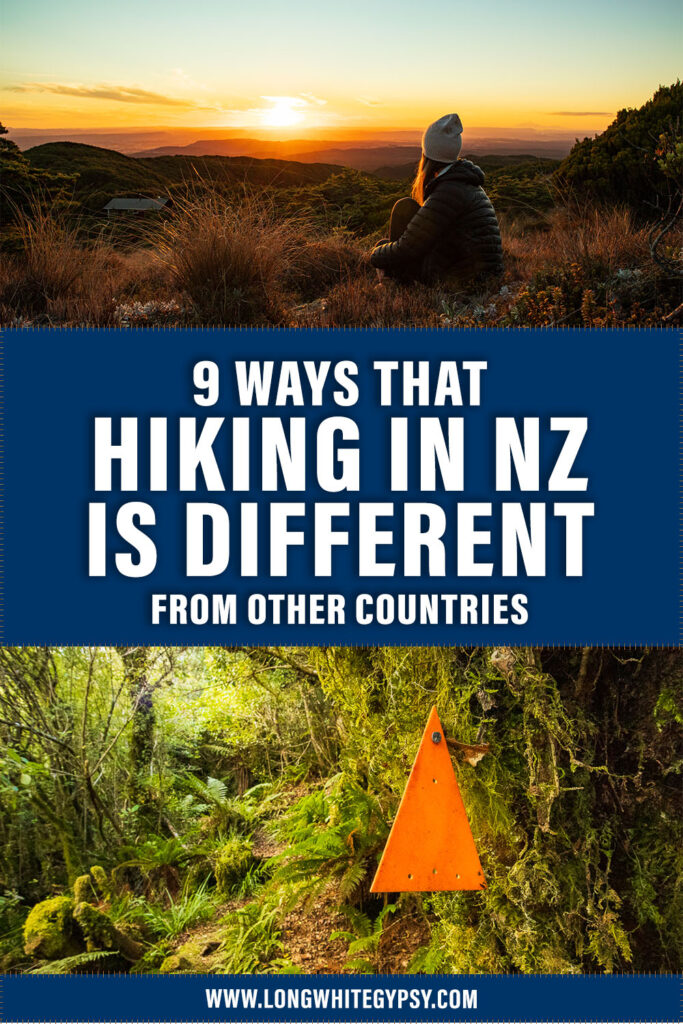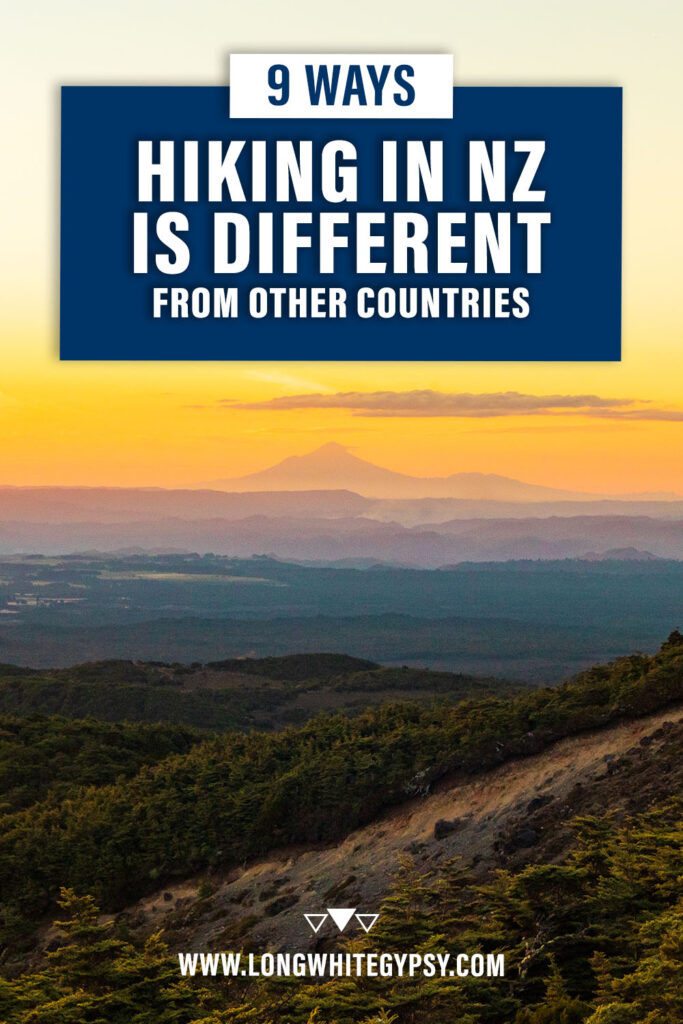Long White Gypsy uses affiliate links and is a member of the Amazon Services LLC Associates Program. If you make a purchase using one of these links, I may receive a small commission at no extra cost to you. See my Privacy Policy for more information.
Hiking in NZ is different from what you might be used to.
If you’re an overseas traveler or tourist either on a hiking holiday or who has decided to do a bit of hiking on their travels throughout NZ, here are 9 reasons why I think hiking in New Zealand is different from hiking in other countries to help you be prepared and stay safe out on the trails.
EDITOR’S NOTE: I’ve tried to write this article with a lighthearted tone as I wholeheartedly believe that New Zealand’s tracks and trails should be enjoyed and explored by all. But I’ve also encountered plenty of international hikers who’ve been blindsided by how technical and comparatively dangerous NZ trails can be. This article is written with a hefty dose of caution to draw your attention to some of the things you may not have considered when planning a hike in NZ.
1 — Beautiful Scenery & Variety of Landscapes
New Zealand is often said to be one of the most beautiful countries in the world. In a single trip from one side of an island to the other you can encounter vast stretches of wild coastline, cavernous river valleys with towering waterfalls, expansive and dense native forests jam packed with birdlife, and rugged and impenetrable mountain peaks.
And whilst the people and culture are just as varied and worthy of exploration, the landscape astounds with some of the most scenic, wild and untouched vistas you’re likely to encounter on your world travels (of course made famous by that movie franchise), all of which best explored on foot on our vast network of trails.
2 — Unpredictable Climate & Weather Patterns
Hiking in NZ is different because our climate is far from settled. A warm, bright and sunny day can turn into a tempest within a matter of hours. As global warming tightens its grip NZ sees increased incidences of flooding and even small tornadoes as squally ocean currents bring a more tropical and changeable climate.
Trampers must constantly be mindful of heavy rainfall events causing rising rivers, strong winds creating fall hazards & hypothermia from wind chill together with abrupt changes in temperature. On the flip side the lack of ozone layer causes UV levels to spike making the sun stronger and leading to sometimes severe sunburn and heatstroke when spending time outside.
There’s a distinct difference between the climates of North and South. The climate morphs from the subtropical humid and stormy north to the crisp and freezing south. Whilst the North Island rarely sees snow during winter, the South is frequently blanketed in it.
Many a tramping trip has come unstuck due to bad weather. In fact the climate is so changeable and unpredictable that it’s common to find plentiful supplies of reading material and even board games in backcountry huts to while away unexpected days spent waiting for weather to abate.
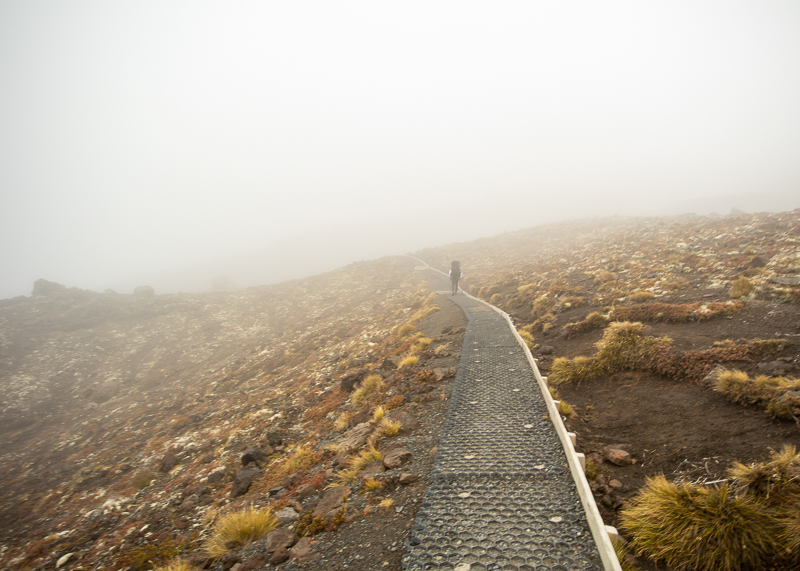
3 — So Many Facilities
Consistently New Zealand’s hiking trails are highly rated by international hikers because of their facilities.
The Department of Conservation in its role as kaitiaki (caretaker) of the environment makes sure that tracks and facilities are well looked after. This includes minimising human effects such as pollution and erosion by making sure there are plenty of toilets, designated camping sites and even boardwalked tracks over erosion-prone sections.
But there’s also a strong safety element to track facilities. Trails are usually very well marked to help stop hikers getting lost, and a network of over 950 backcountry huts keeps hikers warm and dry in the face of the extreme weather fluctuations.
Backcountry huts are fully enclosed structures, usually with some form of heating (although not always) and campsites are selected because they are naturally sheltered or close to water. Most huts and campsites have a water supply (even if it must first be treated before using) and all will have a toilet to promote good leave no trace principles.

4 — The Terrain is Wild & Rugged
From pristine yet remote golden sand beaches to dense forests, alpine passes and everything in between, New Zealand has it all.
Sitting astride two tectonic plates, the country is demarcated by a backbone of rugged mountains running through the centre of the lower North Island and down the length of the South Island. Although this active geological environment creates some of the world’s most spectacular vistas, it also leads to heightened volcanic and seismic activity and dangerous environments (read more about tramping hazards here).
Vast swathes of New Zealand are uninhabited by humans either due to impenetrable mountain ranges or forests and bush which is too dense for roads to be cut through. I often half expect to come across lost dinosaurs as I explore the Jurassic and untouched lost world which exists beyond the bounds of modern civilisation.
Terrain is often so rugged and wild that it’s too difficult for proper trails to be cut, so expect tracks to be much rougher than you might be used to at home.
Oh, and also… there’s no such thing as a switchback in New Zealand! Our tracks and trails go straight up and over hills and mountains making for much steeper and more strenuous hiking!
Finally, New Zealand is a land governed by rivers, and if you venture past the popular Great Walk hiking trips into more advanced multi-day tramping you’ll soon find that your life revolves around them. Most streams and rivers are not bridged, requiring a certain level of skill in first reading a river to ascertain whether it’s safe to cross, and then utilising a safe crossing technique (read more about river safety techniques here).
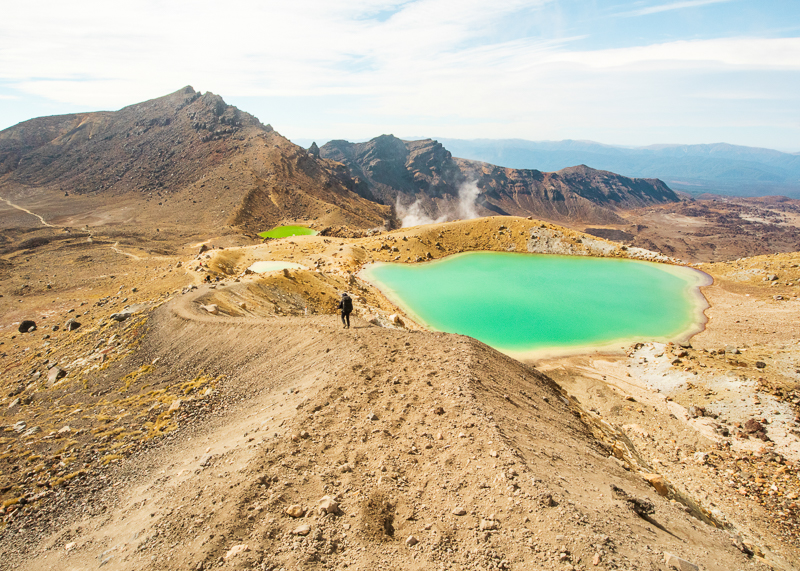
5 — It’s Not Cheap
Extra facilities mean extra cost to maintain tracks and trails to an appropriate standard. Toilets have to be emptied, sections of track have to be cleared, new boardwalks laid, new track markers installed and water tanks cleaned or replaced.
These costs are partly recovered from track users. So if you’re planning on undertaking a multi-day trip in the New Zealand wilderness you need to understand there’s a cost involved.
Firstly, it will probably cost you a small fortune in petrol just to get to the trail. Many of our most popular tracks are located far from main centres. Then, you’ll have to pay a fee for your hut accommodation for the night. Hut fees range from $5 to $15 per night (depending on how many facilities the hut has) and even camping at or near the hut or at a DOC campsite still attracts a small charge ($5-10).
If a track doesn’t start and end in the same place you’ll probably need a shuttle to drop you off and/or pick you up. Shuttle costs vary wildly but as a very general range I’d expect to pay at least $45 to $120 one-way, depending on the track. For some of our Great Walks shuttle costs are much more expensive.
And just to add salt to the wound, if you’re an international visitor exploring NZ during our peak season expect to pay at least $30 more per night to stay on some of our Great Walks (full Great Walks pricing schedule available here).
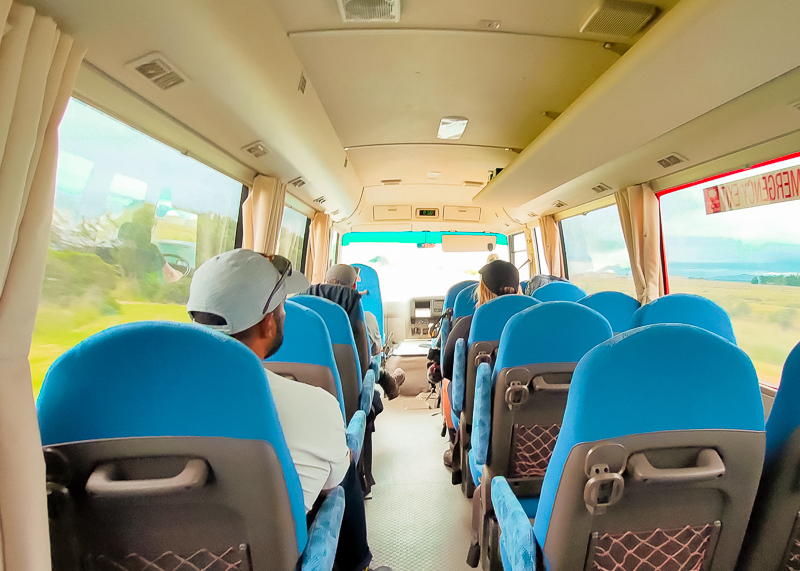
6 — You’re Miles (if not Days) From Anywhere
Hiking in NZ is different because much of New Zealand is remote and inaccessible. Yet some of our most popular tracks and trails wantonly explore these areas.
Take southern Fiordland, for example, where the Hump Ridge Track is fast becoming one of our most popular multi day walks winding as it does through its forgotten corner of the mainland. Or the Whanganui River Journey which traverses a largely untouched and uninhabited national park on the banks of one of our largest rivers.
Tramping in New Zealand means being aware that a trailhead might be a 200 kilometre journey from the nearest town down a long and winding gravel road with no through traffic. It’s acknowledging that even as you start walking you’re getting further away from civilisation. And it’s knowing that even after activating your Personal Locator Beacon, help could still take many hours or even days to arrive (helicopter evacuations may be aborted due to bad weather leaving foot-parties the only option).
If you venture into the NZ backcountry you should go in the knowledge that the only person responsible for your safety is you. Hence why it’s so important to make the right gear choices, prepare well and know what you’re in for when you get out there.
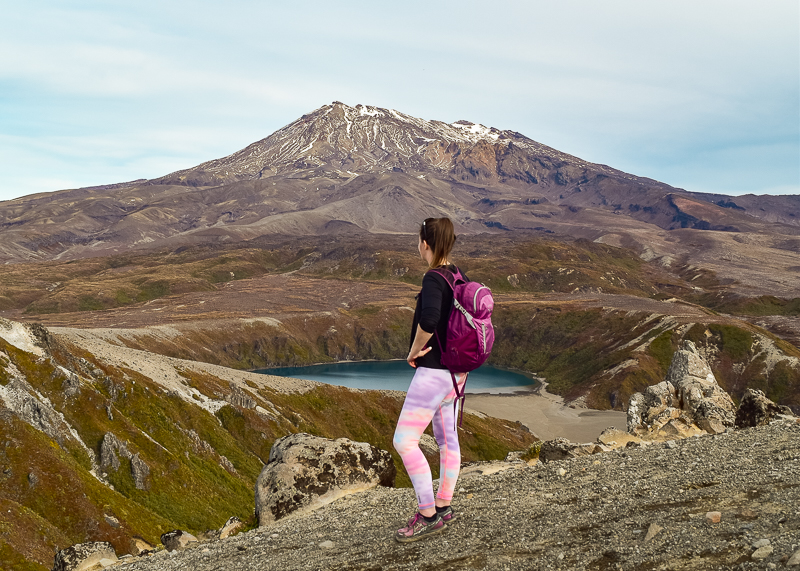
7 — Plan, Plan and Plan Some More
Factors such as weather, remoteness, terrain and difficulty mean that a hiking trip in New Zealand often requires much more planning than you’re used to.
Always check the weather, track information and alerts on the DOC website and/or at the local DOC Visitor Centre before you set out.
Even our most popular tracks and trails are fraught with risk, such as the Tongariro Alpine Crossing which traverses active volcanic territory on advanced terrain, and the Milford Track which involves a dangerous and risky traverse of an exposed alpine pass.
There are very few kiwi ultralight trampers, and for good reason. New Zealand trails simply don’t lend themselves to ultralight hiking. Contingencies are a substantial part of planning a NZ hiking trip where safety means planning for all kinds of weather and all kinds of terrain.
Don’t be fooled by what other kiwi trampers tell you. They’re renowned for downplaying risk and danger (especially as they’re almost always more experienced than you).
Check and double check information you’re given, and seek advice from people who have a similar background and experience level to you.

8 — Nothing is trying to eat (or kill) you
In New Zealand you can hike safe in the knowledge that we don’t have any wild animals that are intent on human flesh. No bears, no mountain lions, no snakes, nothing that could seriously maim or injure you.
Unless of course, you count sandflies.
Widely regarded as the curse of the NZ outdoors, sandflies are tiny black insects that rival mosquitoes for their ability to swarm unwitting hikers as they stop for respite. Their bites leave little red welts that will have you itching for days and they’re much more common than mosquitoes. Insect repellent is a must-have item when hiking in NZ, especially over the summer months when they’re at their worst.
The other main threat you’re likely to face on NZ trails is from cattle. Plenty of our publicly accessible trails pass through working farms. You should know and understand how to behave around cows and sheep before attempting these tracks.
You’ll find plenty of other animals on NZ trails such as deer, goats, wild pigs, possums, mice, rats and more but most will leave you alone if you do them the same courtesy.
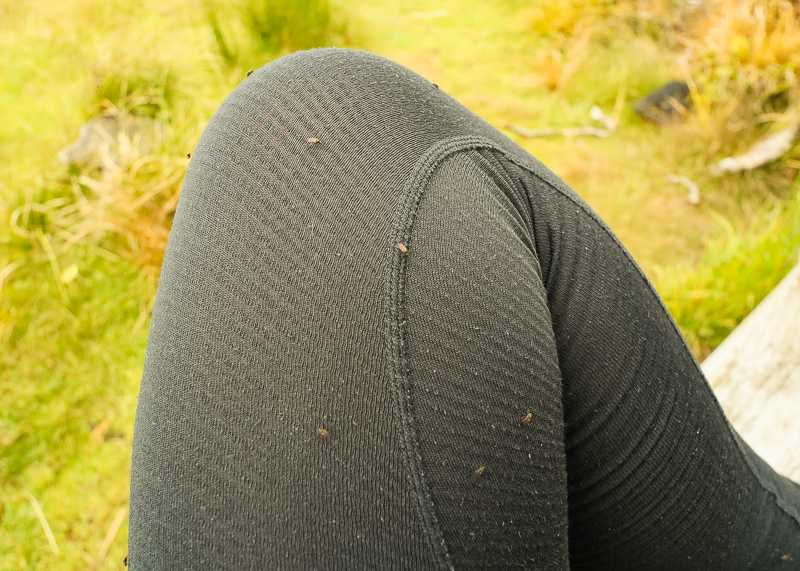
9 — Track Markings & Grades
Hiking in NZ is different because trails are marked by the length of time it takes to complete them (i.e. hours) not by distance (i.e. kilometres).
It might seem strange but this has a lot to do with the dramatic changes in terrain and weather conditions. You may be considering two trails, each 15km long, yet one might take 4 hrs to complete and the other might take 7 to 8 hrs.
Things like the current weather conditions, how steep the track is, whether it’s well cut or if it’s a rough track, whether it has a lot of deep mud or sucking roots, and whether it involves technical terrain (such as scree slopes or narrow ledges) all affect how fast you can hike.
The estimated times given on signs at trailheads and junctions are based on how long it might take an average hiker with the fitness and experience expected of a trail of that grade to complete the track in average weather for that region.
You may need to adjust this time estimate depending on your level of skill, experience & confidence, and the current weather forecast.
There may be a big difference between what is considered an ‘easy’ track in your home country and what is considered ‘easy’ in New Zealand. NZ terrain is rough and wild and even our easier tracks can involve some technical skill. Assess your competence level gradually by starting out slow on shorter day hikes and then progressing to higher grade tracks as you build experience hiking in NZ.
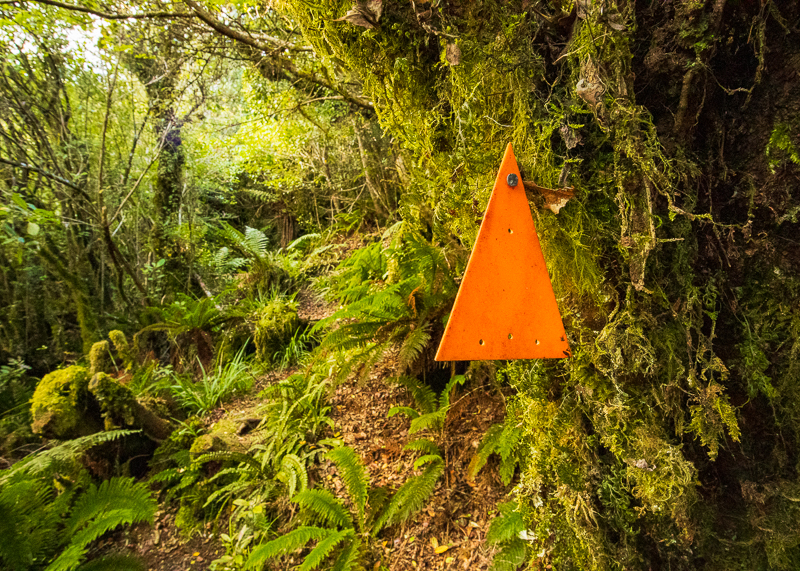
Final Thoughts: 9 reasons why hiking in NZ is different.
New Zealand is a stunningly beautiful country, and one which is often best explored on foot. For the best results, always be well prepared and know what you’re getting yourself into.
Make sure to research tracks and their requirements throughly before setting out. If you’re still unsure, you’re always welcome to reach out to me via my contact page.
For more information on how to start hiking in New Zealand, check out the Hiking for Beginners section of this website.
If you enjoyed this post about how hiking in NZ is different, please take a moment to help me spread the word to other trampers and hikers by sharing it on Pinterest or social media.
[/membership]

